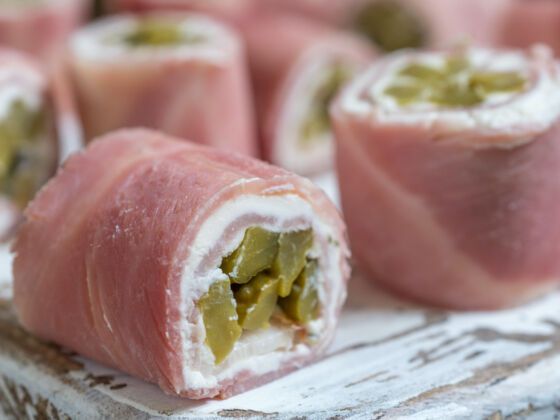It’s a snack known by many names: pickle roll ups, pickle and ham pinwheels, prairie sushi, even Lutheran sushi. But if you’re not from the Midwest, you probably don’t know it by any name. Pickle roll ups might be ubiquitous at family gatherings and cocktail parties from Illinois to Wisconsin, yet as one viral tweet this past November revealed, most people outside of the region haven’t heard of them. As Kari Paul, the tweet’s author, points out, two kinds of people populate the ensuing thread: Midwesterners who are devoted to the snack and people from the rest of the country who are skeptical of it at best, or downright insult the dish at worst. One user even calls it an “abomination.”


Pickle Roll Ups Are Another Genius Culinary Innovation From the Midwest
Like raw meat sandwiches and dessert salad, this Midwestern delicacy is quickly and unfairly maligned just because of its appearance and concept. But pickle roll ups are simple and straightforward in assembly and unite a trio of complementary ingredients: A layer of cream cheese is spread over a thick slice of crisp dill pickle, and is then wrapped in a sheet of ham. The combination of flavors, while perhaps not intuitive, work surprisingly well together.
“What makes pickle wraps great is the combination of textures,” explains Leah Beyer, the Indiana native and recipe blogger behind Beyer Beware. “Refrigerator pickles are best for these because they are the crunchiest pickles. The sweet creaminess of the cream cheese marries the tanginess of the dill pickle with the smoky and salt flavors from the ham or dried beef lunch meat.”
There are a couple of variations of the snack. Some people add an extra layer to the pickle roll up by wrapping the ham in a tortilla. Others blend the ingredients into a dip and serve it with crackers. Snacks like this one tend to appear at family gatherings, where it’s necessary to feed a crowd something satisfying and convenient to eat that can be made in bulk (here again, you might recall the appeal of Jell-O salad).
“I spent most of my childhood growing up in rural Minnesota,” Celine, a New York City-based wine writer, wrote to me in an email. “I remember seeing pickle roll-ups at potluck events, birthday parties, and graduation celebrations, things of that nature — I think I tried one once and just couldn’t handle the texture (I’m not a huge pickle fan to begin with) [but] I see the appeal, especially because cream cheese makes everything better.”
In other families, pickle roll ups only appeared on holidays. Beyer remembers seeing them at “holiday dinners as a snack before the dinner was done.”
“We would have a smorgasbord of items like pickle wraps, meatballs, and cheese and crackers. They were definitely something that we would only have when guests were over,” she adds. “It was not something we would make for just a snack for ourselves. People who are new to them would always hesitate. But they would be and still are the first thing we run out of during gatherings.”
Jen Koellmann, who runs the recipe blog Whole Lotta Yum, agrees that pickle rolls up were generally reserved for the holidays, in particular Christmas.
“There’s quite a bit of nostalgia when I think about pickle rolls, I can’t make them without thinking of grandma and her big plate of them that always got devoured at Christmas,” Koellmann says. “When I was a young child, [she] used to serve them as an appetizer sliced into bitesize pinwheels for family gatherings, sometimes with ham, cream cheese, and pickles and other times without the pickle but with ham, cream cheese, and horseradish sauce.”
Today, she makes me her own version with rosemary ham from Trader Joe’s, whipped cream cheese, and baby dill pickles, sometimes switching out ham for roast beef, salami, or turkey slices.
The origins of pickle roll ups aren’t easy to pin down, but it’s probably safe to assume that German immigration to the region is at the root of its enduring popularity. Darcy Maulsby, a lifelong Iowan and Midwest food historian, told the Des Moines Register that, “Anytime you have a German community or a place with a strong German heritage, you got pickles and red meat and that is two-thirds of a pickle wrap right there.” (Maulsby also declared that Iowa should claim the pickle roll up as their own, though clearly people from Minnesota would disagree.) Similarly, raw meat sandwiches (also known as “wildcat”) eaten by German immigrants in Michigan are an adaptation of the German dish mettbrötchen.
“Since my family has strong German roots, this [wouldn’t] surprise me at all,” says Beyer. “I am sure it was my German grandparents who introduced us to this amazing snack and appetizer.”
Koellmann has a slightly different perspective on the origins of pickle roll ups though.
“Another nickname I’ve heard for pickle roll ups is ‘Lutheran sushi,’ which makes me wonder if these were a common appetizer served at Lutheran church gatherings,” Koellmann explains. “Being that many families of Scandinavian origin attended the Lutheran church (including my family), this was my assumption, but many Germans are Lutheran as well. Since the Midwest had many Scandinavian and German immigrants, either could be the originator of the pickle roll up.”
Why the region’s delicacies are so maligned by the rest of the country remains unclear. It strikes me that the Midwestern tendency to combine ingredients that seem, at first blush, like strange bedfellows but when combined turn out to be iconic pairings (see: the myriad casseroles popular in the region) is industrious, clever, and creative.
“Now my kids are equally obsessed with them and help in the making,” Beyer says. “They are so good. Plain pickles are great snacks, but wrap them in cream cheese and meat and you practically have a complete meal.”